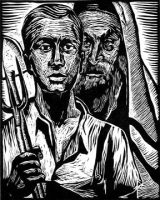09 February 2015
The Left Front: Radical Art in the “Red Decade”, 1929-1940
Grey Art Gallery, NYU
13 January – 4 April 2015
by Joel Bacon
 Title wall: The Left Front: Radical Art in the “Red Decade,” 1929–1940
Title wall: The Left Front: Radical Art in the “Red Decade,” 1929–1940
NEW YORK — A timely exhibition has just opened at the Grey Art Gallery on Washington Square. The Left Front: Radical Art in the “Red Decade”, 1929-1940 brings together American artists who became prime motivators for and voice of the working class during the years between the two world wars. Influenced by the Russian Revolution of 1917 many prominent artists aligned with the socialist movement and in particular John Reed, journalist, poet and founding member of the American Communist Party. John Reed Clubs sprang up throughout the United States. In keeping with Reed’s philosophy of artist as activist the club’s draft manifesto called for all artists and writers to “abandon decisively the treacherous illusion that art can exist for it’s own sake or that the artist can remain remote from historic conflicts in which all men must take sides.” In The Left Front, artists, with both imagery and words, dismantle the myths surrounding corporate and government power and reveal the greed and unfair distribution of wealth away from labor. Morris Topchevsky, Strike Breakers, 1937

The best work in the exhibition operates on two levels. It challenges us visually as it informs us. Among the highlights of the exhibition is a video compiled from old film footage of a 1937 May Day parade where throngs of participants flow through the avenues and parks of Manhattan. Artists, laborers and communist party members alike took to the streets formed into well-organized columns holding banners each representative of their local unions, John Reed Clubs and American Communist Party affiliates. I was impressed by the size of the march and struck by the poignancy of these images and how they parallel modern movements like Occupy Wall Street. Influenced by these activists, Franklin Roosevelt was to enact the New Deal including the Social Security Act, the WPA and the Fair Labor Standards Act. This groundbreaking legislation promoted the strong middle class that grew with the increased union membership after WWII. Before the New Deal labor unions existed without government support and they faced formidable industry backed and government sanctioned opposition. In an uncredited photograph a battalion of federal troops sets up machine gun positions on a Detroit street to suppress strikers. In a large painting by Morris Topchevzky troops with gas masks and shotguns launch teargas canisters into a building occupied by striking workers. A series of etchings by Carl Hoeckner have a beautiful gossamer quality, with phalanxes of muscled figures, some in battle gear in silhouette anticipating the rise of Fascism in Europe and reflecting the anti war sentiment of the artist. Henry Simon’s two large etchings titled Industrial Frankenstein (1 and 2), 1932, humorously depict giant industrial robots which turn on their masters, sending the fat businessmen in top hats and tails scurrying, echoing the “throw the bums out” sentiment directed at Wall Street oligarchs today. In another series of woodblock prints Ceil Rosenberg shows us in New Hope, 1937, a portrayal of a possible utopian Jewish State to be named Biro Bidjam set up somewhere in Soviet Russia. It’s heartbreaking to know how all those hopes were erased so horribly during WWII.


 Carl Hoeckner, Cold Steel, 1935; Carl Henry Simon, Industrial Frankensteins, 1932; Ceil Rosenberg, New Hope, 1937
Carl Hoeckner, Cold Steel, 1935; Carl Henry Simon, Industrial Frankensteins, 1932; Ceil Rosenberg, New Hope, 1937
The Left Front demonstrates that art helped motivate and inspire the American worker to reform the workplace and influence government policy. Now although I would consider any art to be revolutionary and political if it forces the viewer to change or to think and consider alternatives, this exhibition makes a convincing case for artists to take a more active role to create a thriving and inclusive society. The emphasis for the majority of the artists in the exhibition was on not amassing wealth for themselves or their dealers but on the creation of art with a message made available through clubs and circulated widely. There was an attempt by John Reed Clubs to create a culture of artists where art, in order to be meaningful, had to be politically and socially inspired. This contrasts with the traditional notion of art created by “artist as genius, aloof from the world and his historic moment”. Can artists apply today what these revolutionaries tried 75 years ago? Does it make sense to make art without a political or a social message? Is it even possible? What is the responsibility of the art community today? Has the world changed all that much? These are just some of the questions that The Left Front challenges us with. The Left Front: Radical Art in the “Red Decade”, 1929-1940 is at the Grey Gallery at NYU on Washington Square Park and runs till April 4, 2015.